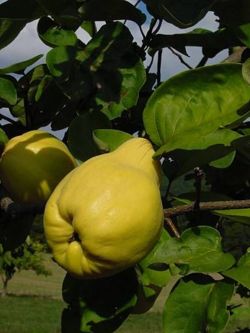Quince
The quince is a small tree or shrub and sole member of the genus Cydonia, family Rosaceae; the name is also used for the fruit of the tree. It is one of the oldest fruits known to mankind, but has been in continuous decline in importance in Europe and North America since the late nineteenth century; in North America, the number of cultivars, or varieties, diminished from 15 in 1888 to only eight by 1925, and continued to decline.[1]
To quote the Food Lover's Companion:
Ancient Romans used the flowers and fruit of the quince tree for everything for perfume to honey. It was also considered a symbol of love and given to one's intended as a sign of commitment.[2]
Today's quince is of far less culinary interest than it has been in the past. Being naturally high in pectin, the fruit is used mainly for jam, jelly, and preserves, but may also be eaten baked or prepared like other fruits.
In the Middle ages quinces were so highly esteemed in France that presents of a quince preserve called cotignac, a sort of marmalade which was a specialty of Orléans, were ordinarily made to kings, queens and princes in cities which were honored by their visits; when Joan of Arc arrived to lift the siege of Orléans, the first gift offered her was cotignac.[3]
Etymologically, the quince is the "fruit from Chaniá", a port on the northwest coast of Crete from which quinces were exported. In ancient times Chaniá was known as Cydonia (in Greek Κυδώνια), so the ancient Greeks called the fruit Κυδώνιον μῆλον ("Cydonian apple"). Latin took the term over as cydōneum, later cotōneum, which passed into English via Old French cooin. The original English form of the word was quoyn, later quyn, but already by the early 14th century its plural quyns was coming to be regarded as a singular. Its geographical origins are unclear—putatively India or Persia—but by 700 BC it was being used by the Greeks as a ritual item in wedding ceremonies.
Quinces are grown under similar conditions to apple and pear trees, and are susceptible to many of the same diseases and pests, such as fire blight and scale insects. It is, however, widely used by commercial growers as a rootstock for grafts of apple and pear trees. Quinces, Waverly Root tells us, once...
...enjoyed a period of popularity along America's eastern coast in Colonial times.... In New England especially, the quince was once common in home gardens and was also grown in commercial orchards, but today it has lost favor even there; it is now the least grown of all tree fruits in the United States.[4]
References
- ↑ Sykes, J. (1972), 'A description of some quince cultivars from Western Turkey', Economic Botany 26/1 [1]
- ↑ The New Food Lover's Companion, Second Edition, by Sharon Tyler Herbst, Barron's, Hauppauge, New York, 1995, ISBN 0-8120-1520-7, page 640
- ↑ Food: An Authoritative and Visual History and Dictionary of the Foods of the World, by Waverly Root, Simon and Schuster, New York, 1980, ISBN 0-671-22589-8, page 394
- ↑ Root, ob. cit. page 396
